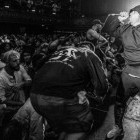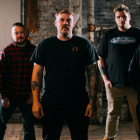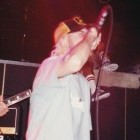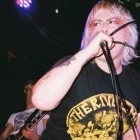
I remember vividly the night I first heard Minor Threat.
I was a mid-'90s teenager and barely familiar with hardcore. By that time I’d heard some later Bad Brains, some Black Flag, and a few newer bands my older friends were into.
On a lark, I decided to try the Minor Threat Complete Discography CD. Standing in the store, I was instantly impacted by the joyless image of Alec Mackaye on the cover. The song titles on the back seemed so powerful. Without ever hearing it, I was hooked on this band.
I got it home to my bedroom, tearing open the cellophane and feeling the creak of opening the brand new jewel case as it revealed the “Bottled Violence” art on the shiny red disc. I remember how my cheap boombox felt when you would press the button, feel the feedback resistance and hear the hiss of the CD starting to turn.
Then it happened. I heard the gnarliest guitar sound my young ears had ever experienced. It didn’t sound like Johnny Ramone or Mick Jones or even Greg Ginn. It sounded broken. It sounded awful. Like Sonic Youth level noise, but faster and sloppier and a guy with an annoying voice started screaming. I hated it. I forced myself to listen to it all that night, because I’d spent all the money I had on it.
After a few days, I started to like it. I listened to it over and over on a dubbed cassette in my car. Eventually, they became my favorite band only a few years later. The guitar had been so off-putting on the first listen now seems so brilliant and perfect and risky.
The man who recorded every second of Complete Discography, as well as most of the early DC hardcore, was Don Zientara. His fingerprints are all over the recorded history of American punk. His home studio, Inner Ear, hosted classic '80s DC bands before moving to a “proper” studio.
Akashic Books just published The Inner Ear of Don Zientara: A Half Century of Recording in One of America’s Most Innovative Studios, Through the Voices of Musicians, a 160-page book of photos of the studio and essays by musicians. The author is photographer Antonia Tricarico.

Tricario’s photos of Don Z’s famous Virginia studio can be seen throughout the book. Henry Rollins recalls his experiences going into Inner Ear with Teen Idles and recording with S.O.A. Kathleen Hanna writes at length about Bikini Kill’s time making their self-titled EP for Kill Rock Stars with Ian Mackaye and Don Z manning the boards. Jad and David Fair of Half Japanese recount their early recording sessions, stuffing the Zientara family basement with three drum kits and all of their equipment for a live recording session.
Producer/engineer J. Robbins wrote about how he was offered to run Inner Ear studio B after the breakup of his band Jawbox, crediting Zientara for so much of Robbins’s own career behind the boards with bands like Jets to Brazil, Modern Life Is War, The Sword, and Against Me! And Chili Pepper/guitar virtuoso John Frusciante eloquently lays out why he loved working at Inner Ear for his solo record DC.
There are memories retold by members of Fugazi, Void, Fire Party, Nation of Ulysses, Shudder to Think, and Jawbox, to name just a few of the studio's alumni. Along with the photos from Tricarico’s time at the studio, the book shows the work of Instrument director Jem Cohen and vérité pics from the musicians who recorded with Don Z.

The stories of many of the recording sessions repeat a lot of the same themes. A windowless basement that stayed sweltering in the humid DC summer. A home studio built to encourage creativity and playfulness. But most of all, Tricarico shows how much people really loved working with Don Z, a former army electrician who taught himself how to build recording gear.
Zientara was noted for how far off the mark he was from the punk aesthetic, a former folk guitarist who was often seen in running shorts and flip-flops, showing teenagers and amateurs how to make the music that they wanted to create. The encouragement and kindness of Zientara are repeated over and over throughout
Tricarico’s masterfully curated book, whether it was in his home or the professional space where Inner Ear operated for its last 30 years. The music we know from the metro DC area – and beyond – was such an extension of Don Z’s work. He recorded the Bad Brains demo (reissued as Black Dots) on his TEAC 4-track, a cassette that circulated the East Coast and offered the template for what hardcore punk could be.

Recording some local high schoolers, Zientara forever linked his name to Ian Mackaye, Dischord Records and the world that emerged from the label. His reputation offered him the chance to document the fringe of rock music happening on the East Coast over the last 45 years. Without a space these young bands could be free to pursue their own creativity, the culture that grew from DC punk might never have taken roots.
Get It
- Amazon (Book)
Tagged: bikini kill, jawbox, minor threat




















